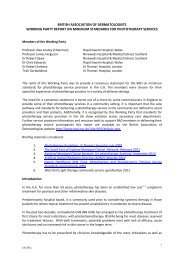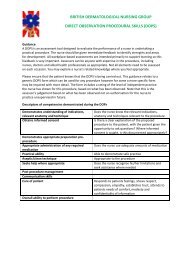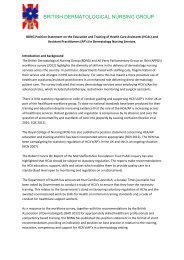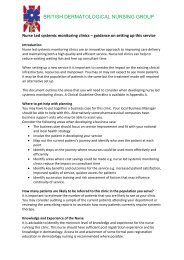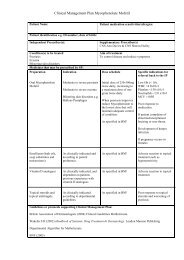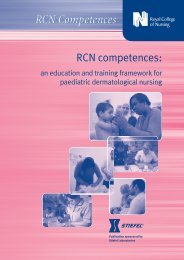Improving outcomes for people with skin tumours including melanoma
Improving outcomes for people with skin tumours including melanoma
Improving outcomes for people with skin tumours including melanoma
You also want an ePaper? Increase the reach of your titles
YUMPU automatically turns print PDFs into web optimized ePapers that Google loves.
<strong>Improving</strong> Outcomes <strong>for</strong><br />
People <strong>with</strong> Skin Tumours<br />
<strong>including</strong> Melanoma<br />
Initial investigation,<br />
diagnosis, staging and<br />
management<br />
Evidence from observational studies does not support widespread,<br />
routine use of CT in the management of patients <strong>with</strong> <strong>melanoma</strong>, but<br />
supports consideration of CT on an individual basis.<br />
Surgical therapies<br />
Surgical excision is the standard therapy <strong>for</strong> the great majority of <strong>skin</strong><br />
cancers.<br />
Evidence-based guidelines from the UK recommend that lesions<br />
suspected of being <strong>melanoma</strong> are initially excised as full-thickness<br />
<strong>skin</strong> biopsies, <strong>including</strong> the whole lesion <strong>with</strong> a 2–5 mm clinical<br />
margin of normal <strong>skin</strong> laterally and <strong>with</strong> a cuff of sub-dermal fat.<br />
Histologically confirmed <strong>melanoma</strong> <strong>tumours</strong> require referral to a<br />
specialist centre <strong>for</strong> excision, <strong>with</strong> a margin of between 1 cm and 3<br />
cm, stratified according to Breslow thickness.<br />
4<br />
Evidence from two systematic reviews suggests that in the excision of<br />
<strong>melanoma</strong> surgical margins of 3–5 cm have no advantage, in terms of<br />
local recurrence, overall survival and disease-free survival, over<br />
margins of 1–2 cm.<br />
One RCT that compared 1 cm versus 3 cm surgical excision margins<br />
<strong>for</strong> <strong>melanoma</strong> found an advantage of borderline statistical significance<br />
in terms of locoregional recurrence <strong>for</strong> 3 cm margins over 1 cm<br />
margins, <strong>with</strong> no significant difference in survival detected.<br />
Mohs micrographic surgery<br />
There is systematic review evidence to support the use of Mohs<br />
surgery <strong>for</strong> large, high-risk BCCs located at surgically complex regions<br />
of the face.<br />
Systematic review evidence also exists <strong>for</strong> the use of Mohs surgery in<br />
patients <strong>with</strong> recurrent NMSCs, in patients <strong>with</strong> <strong>tumours</strong> <strong>with</strong><br />
aggressive growth histology and in patients <strong>with</strong> large NMSCs <strong>with</strong><br />
indistinct margins.<br />
Sentinel node biopsy (SNB)<br />
No randomised controlled trials reporting on survival following SNB in<br />
patients <strong>with</strong> <strong>melanoma</strong> have been published. There is good evidence<br />
that SNB <strong>for</strong> <strong>melanoma</strong> may be useful as a staging investigation, and<br />
participation in EORTC adjuvant trials may become dependent on its<br />
availability.<br />
92<br />
National Institute <strong>for</strong> Health and Clinical Excellence




